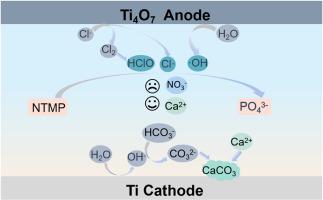现实条件下Ti4O7电极对磷酸盐的高效降解:HOCl和长期稳定性的关键贡献
IF 8.1
2区 环境科学与生态学
Q1 ENVIRONMENTAL SCIENCES
引用次数: 0
摘要
在冷却水中使用含磷阻垢剂(即膦酸盐)对排放过程中的水污染和富营养化提出了重大挑战。本文报道了一种基于低成本亚氧化钛(Ti4O7)惰性阳极的高效电化学氧化(EO)工艺。我们发现,冷却水中普遍存在的氯离子(Cl−)显著促进了亚甲基膦酸(NTMP)向正磷酸盐的转化。在Cl−-Ti4O7-AO体系中,次氯酸(HOCl)是主要的反应物质,负责C-P和C-C键的顺序裂解,将有机磷转化为无机磷酸盐。此外,在现实条件下,HCO3−或腐植酸(HA)的存在对NTMP降解的影响可以忽略不计。在长期运行中,即使阴极几乎完全被CaCO3沉积物覆盖,Ti4O7-AO系统在连续流运行模式下仍能保持100%的NTMP转换效率超过720小时。结果表明,阴极结垢对Ti4O7-AO体系中有机磷向磷酸盐的转化影响不大。总的来说,我们的研究阐明了Cl−-Ti4O7-AO体系处理含磷酸盐废水的机理和强大的效率,并为电化学氧化与无处不在的氯离子耦合处理冷却水提供了一种新的解决方案。本文章由计算机程序翻译,如有差异,请以英文原文为准。

Efficient phosphonate degradation by Ti4O7 electrode under realistic conditions: Key contribution of HOCl and long-term stability
Using phosphorus-containing scale inhibitors (i.e., phosphonates) in cooling water poses a significant challenge to water pollution and eutrophication during discharge. Here we report an efficient electrochemical oxidation (EO) process based on a low-cost titanium suboxide (Ti4O7) inert anode. We found that ubiquitous chloride ions (Cl−) in cooling water significantly promoted the transformation of methylene phosphonic acid (NTMP, a representative phosphonate) into orthophosphate. In the Cl−-Ti4O7-AO system, hypochlorous acid (HOCl) is the primary reactive species responsible for the sequential cleavage of C–P and C–C bonds, converting organic phosphorus into inorganic phosphate. Furthermore, the presence of HCO3− or humic acid (HA) under realistic conditions showed negligible effects on the degradation of NTMP. In long-term operation, the Ti4O7-AO system sustained 100% conversion efficiency of NTMP over continuous-flow operation mode for more than 720 h, even though the cathode was almost entirely covered with CaCO3 deposits. The results revealed that cathode scaling does not profoundly affect the conversion of organic phosphorus to phosphate in the Ti4O7-AO system. Overall, our study elucidates the mechanism and robust efficiency of the Cl−-Ti4O7-AO system in treating phosphonate-laden wastewater and offers a new solution for dealing with cooling water by coupling electrochemical oxidation with ubiquitous chloride ions.
求助全文
通过发布文献求助,成功后即可免费获取论文全文。
去求助
来源期刊

Chemosphere
环境科学-环境科学
CiteScore
15.80
自引率
8.00%
发文量
4975
审稿时长
3.4 months
期刊介绍:
Chemosphere, being an international multidisciplinary journal, is dedicated to publishing original communications and review articles on chemicals in the environment. The scope covers a wide range of topics, including the identification, quantification, behavior, fate, toxicology, treatment, and remediation of chemicals in the bio-, hydro-, litho-, and atmosphere, ensuring the broad dissemination of research in this field.
 求助内容:
求助内容: 应助结果提醒方式:
应助结果提醒方式:


